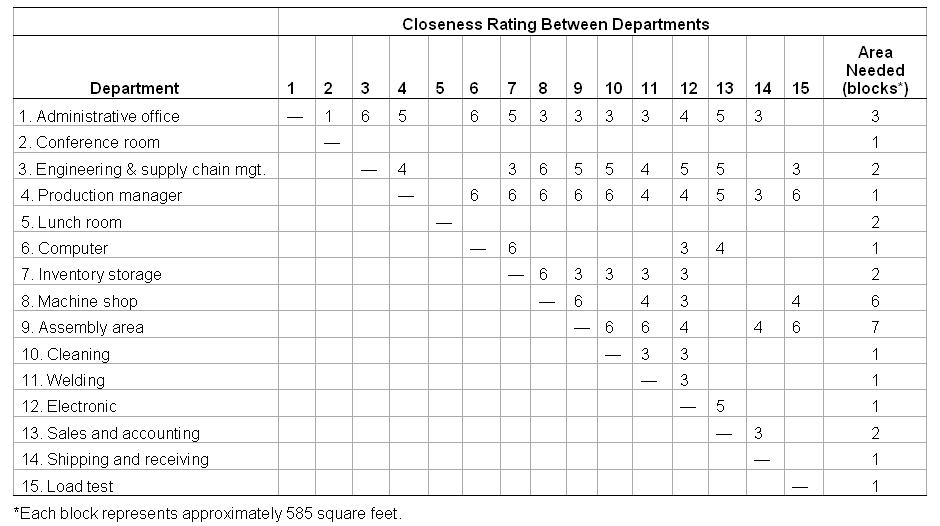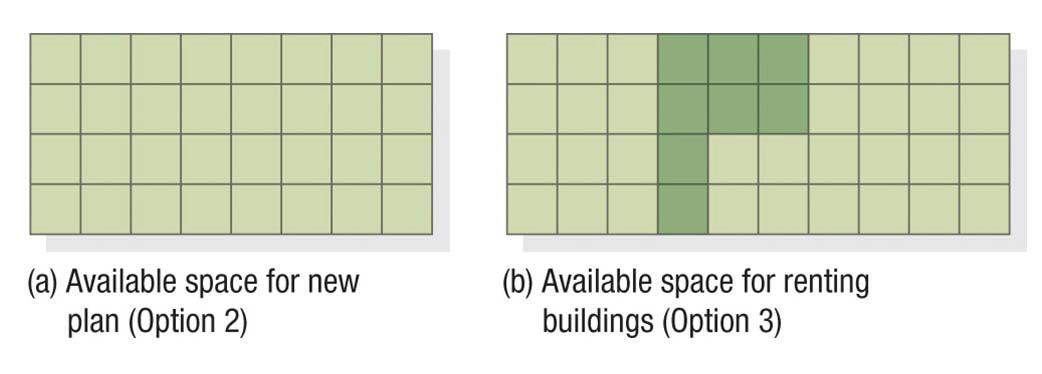Question
Consider an outpatient surgery center that is located in a rectangular building that is 90 feet by 50 feet. There are six departments, each of
- Consider an outpatient surgery center that is located in a rectangular building that is 90 feet by 50 feet. There are six departments, each of which is 30 feet by 25 feet in size. Using the “Patient Traffic per Week” matrix.
Registration | Exam | Operating | Recovery | Labs/Tests | X-ray | |
Registration Exam Operating Recovery Labs/Tests X-ray | ---- ---- ---- ---- ---- ---- | 100 ---- ---- ---- ---- ---- | 20 50 ---- ---- ---- ---- | 0 0 70 ---- ---- ---- | 40 20 0 5 ---- ---- | 10 20 0 5 20 ---- |
QUESTIONS
- Determine the total cost per day of the following initial layout. Assuming it cost $5 to move patients between adjacent rooms. Use rectilinear distances.
REGISTRATION | X-RAY | EXAM |
OPERATING | LABS/TESTS | RECOVERY |
- Design the effective layout that produces the minimum cost per day.
- CASE: Hightec, Inc.
“It’s hard to believe,” thought Glenn Moore as he walked into the employee lunch area, “that it has been only 6 years since I founded Hightec.” He was not interested in lunch because it was only 9:30 A.M. His purpose was to inspect the new computer station, which had just been purchased to improve management of the company’s inventory and accounting functions. The computer had to be housed at the rear of the employee lunch area, right next to the coffee, hot soup, and hot chocolate vending machines. There was absolutely no room for the computer elsewhere.
Hightec is a manufacturer of transducers, which convert gas or liquid pressure into an electrical signal. Another form of the device converts weight or force into an electrical signal. A typical customer order is for only 3 to 10 units. The firm currently rents a 12,000-square-foot, L-shaped building, housing four basic sections: the office area, an engineering area, a machine shop, and an assembly area. The 80 employees comprise machinists, engineers, assemblers, secretaries, and salespeople.
Although Moore concentrated on finance and marketing during the first two years of Hightec’s existence, his activities now are more concerned with production costs, inventory, and capacity. Sales have been increasing about 30 percent per year, and this growth is expected to continue. Specific symptoms of Hightec’s problems include the following.
• Space limitations delayed the purchase of a numerical control machine and a more efficient testing machine. Both promise greater capacity and higher productivity, and their costs are easily justified.
• The machine shop is so crowded that equipment not in constant use had to be moved into the inventory storage area.
• More machines are being operated on second and third shifts than would normally be justified. Productivity is falling, and quality is slipping.
• Approximately 10 percent of the workforce’s time is spent moving materials to and from the inventory storage area, where inventory at all stages of production is kept. The chaotic supply room makes finding wanted parts difficult, and considerable time is lost searching.
• Approximately 1,000 square feet of storage space must be rented outside the plant.
• Lack of capacity has forced Moore to forgo bidding on several attractive jobs. One salesperson is particularly disgruntled because she lost a potentially large commission.
• Several office workers have complained about the cramped quarters and lack of privacy. The quality of employee space also leaves an unfavorable impression on prospective customers who visit the plant.
• Additional help was just hired for the office. To make room for their desks, Moore had to discard his favorite tropical plant, which started as a cutting when Hightec was formed and had sentimental value.
The Options
Glenn Moore identified three options for increasing capacity at Hightec. The first is to renew the rental contract on the current facility for another 5 years and rent portable units to ease the cramped conditions. He discarded this option as being inadequate for a growing problem. The second option is to purchase land and build a new 19,000- square-foot facility. The most attractive site would cost $100,000 for land, and the construction cost is estimated at $40 per square foot. His cost of capital is about 15 percent.
The third option is to renew the rental contract on the current building for another 5 years and rent an adjacent 7,000-square-foot building only 30 feet from the current one. The rental cost of both buildings would be $2,800 per month. Moore’s choice of this third option would necessitate building a $15,000 corridor connecting the buildings. However, Moore estimates the relocation costs (such as for moving and installing the machines and the loss of regular-time capacity) to be $20,000 less than with the second alternative.
The Layout
Regardless of which option Moore chooses, he must improve on the existing layout. It suffers in terms of materials handling costs and departmental coordination. When Moore initially designed the existing layout, he located the office first and then fit the other departments around it as best he could. The main consideration for the other departments was not to have the machine shop next to the cleaning room. Moore put together the information needed for planning the new layout, as shown in Exhibit 1 and Exhibit 2. The projected area requirements should be sufficient for the next 5 years. Both layouts provide for 19,000 square feet. The closeness matrix emphasizes materials handling and communication patterns.
Glenn Moore walked back to the office with a fresh cup of coffee in his hand. He hated hot chocolate, and it was too early for soup. He wondered what he should do next. Whatever the choice, he wanted a more attractive work environment for the engineering and supply chain management staffs, currently located in a cramped, open- office setting. Attracting creative people in these areas had been difficult. He made a mental note that the adjacent building also is quite drab.
QUESTIONS
- Which expansion option would you recommend to Glenn Moore? Justify your position.
- Design an effective block plan and evaluate it. Cite any qualitative considerations that you believe make your design attractive.
Exhibit 1 Closeness Matrix

 Exhibit 2 Available Space for Options 2 and Option 3
Exhibit 2 Available Space for Options 2 and Option 3
In solving this case, you may want to conduct a financial analysis (NPV-Net Present Value Analysis), see Supplement F and Exhibit 3 for commercial real estate depreciation.
Exhibit 3 MACRS – 31.5-YR COMMERCIAL REAL ESTATE
Mo/Yr | 1 | 2-7 | 8-26 Even yrs | 9-31 Odd yrs | 32 | 33 |
Jan | 3.042 | 3.175 | 3.175 | 3.174 | 1.720 | 0.000 |
Feb | 2.778 | 3.175 | 3.174 | 3.175 | 1.984 | 0.000 |
Mar | 2.513 | 3.175 | 3.175 | 3.174 | 2.249 | 0.000 |
Apr | 2.249 | 3.175 | 3.174 | 3.175 | 2.513 | 0.000 |
May | 1.984 | 3.175 | 3.175 | 3.174 | 2.778 | 0.000 |
Jun | 1.720 | 3.175 | 3.174 | 3.175 | 3.042 | 0.000 |
Jul | 1.455 | 3.175 | 3.175 | 3.174 | 3.175 | 0.132 |
Aug | 1.190 | 3.175 | 3.175 | 3.175 | 3.174 | 0.397 |
Sep | 0.926 | 3.175 | 3.175 | 3.174 | 3.175 | 0.661 |
Oct | 0.661 | 3.175 | 3.175 | 3.175 | 3.174 | 0.926 |
Nov | 0.397 | 3.175 | 3.175 | 3.174 | 3.175 | 1.190 |
Dec | 0.132 | 3.175 | 3.175 | 3.175 | 3.174 | 1.455 |
Average | 1.588 | 3.175 |
Department 1. Administrative office 2. Conference room 3. Engineering & supply chain mgt. 4. Production manager 5. Lunch room 6. Computer 7. Inventory storage 8. Machine shop 9. Assembly area 10. Cleaning 11. Welding 12. Electronic 1 NOTE 2 1 3 6 (0) Closeness Rating Between Departments 4 5 4 - 13. Sales and accounting 14. Shipping and receiving 15. Load test *Each block represents approximately 585 square feet. 5 6 6 6 7 8 9 10 5 3 3 3 3 6 6 - 6 5 6 6 6 T 5 6 3 3 6 - 6 - 11 3 4 4 3 4 6 3 - 12 13 4 5 5 LO T 4 3 w w 3 3 4 3 3 01 50 50 4 01 5 - 14 3 3 3 15 - 3 6 4 4 6 st T Area Needed (blocks*) 3 1 2 1 2 1 2 6 7 1 1 1 2 1 1
Step by Step Solution
3.39 Rating (161 Votes )
There are 3 Steps involved in it
Step: 1
Question A Determine the total cost per week of the initial layout Assuming it ...
Get Instant Access to Expert-Tailored Solutions
See step-by-step solutions with expert insights and AI powered tools for academic success
Step: 2

Step: 3

Ace Your Homework with AI
Get the answers you need in no time with our AI-driven, step-by-step assistance
Get Started


